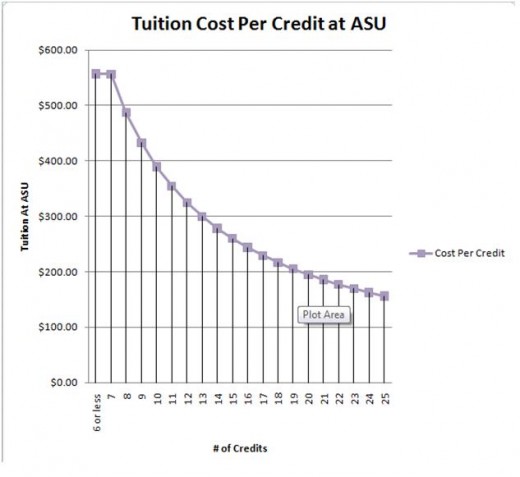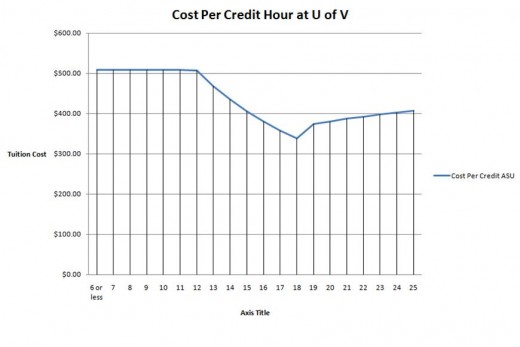How to Save on a Bachelors Degree -- College Tips from a College Student
Tuition can range anywhere from $1,000 to over $40,000 a semester for college students. It is the largest college expense for students, and the reason many do not end up going to college. It's hard to minimize tuition costs; there's no room for haggling or finding discounts. All that most students can do is get scholarships or grants, and hope that tuition hikes don't rise above the amount allocated to them by their funds.
As a student, I know how hard it is to deal with tuition costs. It can easily suck your savings dry if you pay for it out of pocket. You need to understand how tuition works before you can understand where your money is going.
How Tuition Costs Work
Many schools follow the step cost structure for tuition; this means that for every succesive credit hour, they will tack on an extra fee. Arizona State University, in 2011, charged students around $557 a credit for students taking 6 or less credit hours. Based on this cost structure a Bachelors degree (120+ Credit hours total) at ASU can cost a student upwards of $66,000.
University of Vermont, with one of the higher in-state tuition costs in the U.S. (based on 2004 data) charges students $508 per credit in 2011. While this seems like the total cost for a degree would be less than at Arizona State Univerity, this is not true at all. U of V has a different cost structure than ASU, and actually charges more, overall, than ASU does.
This is because all colleges have a limit for tuition costs over a certain number of credit hours. Typically this limit is somewhere between 7-12 credit hours. ASU puts its limit at 7, while U of V puts it at 12.
This limit (no matter what credit number it is at) is where thousands of dollars in savings can be found!
Tution Cost per Cedit at ASU 2011

Cost per Credit at U of V 2011

How to Save Thousands on a Degree
So here is the key to saving money on tuition over time:
Take as many classes in one semester as you are mentally able to handle.
Here's the logic behind it.
Take a college with a step cost structure that has a limit for tuition at 7 credit hours (Such as ASU). For every successive credit hour above 7 credits, the tuition does not cost a cent more, which means that the overall tuition cost is spread over more credit.
If you take 7 or less credits a semester at ASU, your 120 credit degree will cost around $66,840. If you take 12 credits (the minimum to be considered a full time student), a 120 credit degree will cost $38,970. If you take 18 credit hours, a 120 credit degree will cost $25,980, and so on. You could be saving anywhere from $4,000-$40,000 on a degree by taking more credits a semester.
The University of Vermont situation is a little trickier. Instead of a basic step cost structure, we have a tuition range within a step cost structure. This means that the maximum credit hours you want to take in order to see the maximum cost savings would be the upper boundry of the range (for U of V, 18 credit hours). But, you could still be saving as much as $20,000 on a degree by taking 18 credits over 12 credits.
How you get the Savings
1. Taking more Credits means you can Graduate early:
If you are a full time student (between 12+ credits or 12-18 credits), your tuition will be approximately the same every semester (not taking tuition increases into consideration). This means that you save money by paying for fewer semesters.
12 Credits = 10 semesters
15 Credits = 8 semesters
18 Credits = 7 semesters
20 Credits = 6 semesters
For every semester, you can see savings from $4,000 to $10,000, depending on tuition cost for your University.
2. Get 2 degrees from Extra Credits Hours:
If you don't want to graduate early, but you want to get more bang for your buck, you can take those extra credits and apply them towards a second major. This will make you more competative in the job market, and can make you worth more to potential employers (higher return on investment!). A second major can mean anywhere from 30-60 more credit hours to graduate. This means you will need to take 20+ credits a semester to graduate on time, but it is well worth it.
Remember, Be Cautious!
Never take Summer or Winter Courses:
These are a waste of your money, even if you want to graduate early. Just take more credits a semester, it will save you more money in the end.
Be Smart, Plan ahead:
Always consider how much work is required for each course, and try to balance each semester. Try to spread out your difficult classes across multiple semesters to help you succed in taking more credit hours.
Don't overload your Senior Year:
If you are like me, and an over achiever (2 majors, 2 minors), make sure to knock out most of those credits in the first few semesters. Your senior year will be hard enough without adding 25 credit hours a semester to the plate. Always plan ahead!








